+ Open data
Open data
- Basic information
Basic information
| Entry | Database: PDB / ID: 5czh | ||||||
|---|---|---|---|---|---|---|---|
| Title | EGFR L858R MUTANT IN COMPLEX WITH AN OPTIMAL PEPTIDE SUBSTRATE | ||||||
 Components Components |
| ||||||
 Keywords Keywords | TRANSFERASE / EGFR / L858R / KINASE / EGF | ||||||
| Function / homology |  Function and homology information Function and homology informationmultivesicular body, internal vesicle lumen / negative regulation of cardiocyte differentiation / Shc-EGFR complex / positive regulation of protein kinase C signaling / Inhibition of Signaling by Overexpressed EGFR / epidermal growth factor receptor activity / EGFR interacts with phospholipase C-gamma / regulation of peptidyl-tyrosine phosphorylation / epidermal growth factor binding / response to UV-A ...multivesicular body, internal vesicle lumen / negative regulation of cardiocyte differentiation / Shc-EGFR complex / positive regulation of protein kinase C signaling / Inhibition of Signaling by Overexpressed EGFR / epidermal growth factor receptor activity / EGFR interacts with phospholipase C-gamma / regulation of peptidyl-tyrosine phosphorylation / epidermal growth factor binding / response to UV-A / PLCG1 events in ERBB2 signaling / ERBB2-EGFR signaling pathway / morphogenesis of an epithelial fold / PTK6 promotes HIF1A stabilization / ERBB2 Activates PTK6 Signaling / digestive tract morphogenesis / Signaling by EGFR / intracellular vesicle / negative regulation of epidermal growth factor receptor signaling pathway / eyelid development in camera-type eye / cerebral cortex cell migration / protein insertion into membrane / ERBB2 Regulates Cell Motility / protein tyrosine kinase activator activity / Respiratory syncytial virus (RSV) attachment and entry / Signaling by ERBB4 / PI3K events in ERBB2 signaling / positive regulation of phosphorylation / positive regulation of peptidyl-serine phosphorylation / Estrogen-dependent nuclear events downstream of ESR-membrane signaling / hair follicle development / MAP kinase kinase kinase activity / GAB1 signalosome / positive regulation of G1/S transition of mitotic cell cycle / embryonic placenta development / salivary gland morphogenesis / Signaling by ERBB2 / TFAP2 (AP-2) family regulates transcription of growth factors and their receptors / GRB2 events in EGFR signaling / SHC1 events in EGFR signaling / transmembrane receptor protein tyrosine kinase activity / EGFR Transactivation by Gastrin / GRB2 events in ERBB2 signaling / ossification / SHC1 events in ERBB2 signaling / positive regulation of DNA repair / basal plasma membrane / cellular response to epidermal growth factor stimulus / positive regulation of DNA replication / epithelial cell proliferation / positive regulation of epithelial cell proliferation / Signal transduction by L1 / positive regulation of protein localization to plasma membrane / NOTCH3 Activation and Transmission of Signal to the Nucleus / cellular response to amino acid stimulus / phosphatidylinositol 3-kinase/protein kinase B signal transduction / cellular response to estradiol stimulus / EGFR downregulation / clathrin-coated endocytic vesicle membrane / Signaling by ERBB2 TMD/JMD mutants / Constitutive Signaling by EGFRvIII / cell-cell adhesion / receptor protein-tyrosine kinase / Signaling by ERBB2 ECD mutants / negative regulation of protein catabolic process / Signaling by ERBB2 KD Mutants / positive regulation of miRNA transcription / kinase binding / ruffle membrane / Downregulation of ERBB2 signaling / epidermal growth factor receptor signaling pathway / positive regulation of protein phosphorylation / cell morphogenesis / neuron differentiation / positive regulation of fibroblast proliferation / HCMV Early Events / Constitutive Signaling by Aberrant PI3K in Cancer / actin filament binding / cell junction / transmembrane signaling receptor activity / positive regulation of canonical Wnt signaling pathway / Cargo recognition for clathrin-mediated endocytosis / PIP3 activates AKT signaling / Constitutive Signaling by Ligand-Responsive EGFR Cancer Variants / Clathrin-mediated endocytosis / ATPase binding / virus receptor activity / PI5P, PP2A and IER3 Regulate PI3K/AKT Signaling / RAF/MAP kinase cascade / positive regulation of cell growth / double-stranded DNA binding / protein tyrosine kinase activity / early endosome membrane / protein phosphatase binding / nuclear membrane / basolateral plasma membrane / learning or memory / Extra-nuclear estrogen signaling / cell surface receptor signaling pathway / positive regulation of ERK1 and ERK2 cascade Similarity search - Function | ||||||
| Biological species |  Homo sapiens (human) Homo sapiens (human) | ||||||
| Method |  X-RAY DIFFRACTION / X-RAY DIFFRACTION /  SYNCHROTRON / SYNCHROTRON /  FOURIER SYNTHESIS / Resolution: 2.8 Å FOURIER SYNTHESIS / Resolution: 2.8 Å | ||||||
 Authors Authors | Yun, C.H. / Eck, M.J. | ||||||
 Citation Citation |  Journal: Nat.Struct.Mol.Biol. / Year: 2015 Journal: Nat.Struct.Mol.Biol. / Year: 2015Title: EGF-receptor specificity for phosphotyrosine-primed substrates provides signal integration with Src. Authors: Begley, M.J. / Yun, C.H. / Gewinner, C.A. / Asara, J.M. / Johnson, J.L. / Coyle, A.J. / Eck, M.J. / Apostolou, I. / Cantley, L.C. | ||||||
| History |
|
- Structure visualization
Structure visualization
| Structure viewer | Molecule:  Molmil Molmil Jmol/JSmol Jmol/JSmol |
|---|
- Downloads & links
Downloads & links
- Download
Download
| PDBx/mmCIF format |  5czh.cif.gz 5czh.cif.gz | 79.9 KB | Display |  PDBx/mmCIF format PDBx/mmCIF format |
|---|---|---|---|---|
| PDB format |  pdb5czh.ent.gz pdb5czh.ent.gz | 57.7 KB | Display |  PDB format PDB format |
| PDBx/mmJSON format |  5czh.json.gz 5czh.json.gz | Tree view |  PDBx/mmJSON format PDBx/mmJSON format | |
| Others |  Other downloads Other downloads |
-Validation report
| Summary document |  5czh_validation.pdf.gz 5czh_validation.pdf.gz | 444 KB | Display |  wwPDB validaton report wwPDB validaton report |
|---|---|---|---|---|
| Full document |  5czh_full_validation.pdf.gz 5czh_full_validation.pdf.gz | 453.6 KB | Display | |
| Data in XML |  5czh_validation.xml.gz 5czh_validation.xml.gz | 15.3 KB | Display | |
| Data in CIF |  5czh_validation.cif.gz 5czh_validation.cif.gz | 20.4 KB | Display | |
| Arichive directory |  https://data.pdbj.org/pub/pdb/validation_reports/cz/5czh https://data.pdbj.org/pub/pdb/validation_reports/cz/5czh ftp://data.pdbj.org/pub/pdb/validation_reports/cz/5czh ftp://data.pdbj.org/pub/pdb/validation_reports/cz/5czh | HTTPS FTP |
-Related structure data
| Related structure data |  5cziC 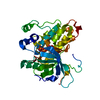 2itvS C: citing same article ( S: Starting model for refinement |
|---|---|
| Similar structure data |
- Links
Links
- Assembly
Assembly
| Deposited unit | 
| ||||||||
|---|---|---|---|---|---|---|---|---|---|
| 1 |
| ||||||||
| Unit cell |
|
- Components
Components
| #1: Protein | Mass: 37676.484 Da / Num. of mol.: 1 / Fragment: EGFR UNP RESIDUES 694-1022 / Mutation: L858R Source method: isolated from a genetically manipulated source Source: (gene. exp.)  Homo sapiens (human) / Gene: EGFR, ERBB, ERBB1, HER1 / Production host: Homo sapiens (human) / Gene: EGFR, ERBB, ERBB1, HER1 / Production host:  References: UniProt: P00533, receptor protein-tyrosine kinase |
|---|---|
| #2: Protein/peptide | Mass: 1252.131 Da / Num. of mol.: 1 / Source method: obtained synthetically Details: THE OPTIMIZED PEPTIDE WAS GENERATED BY LIBRARY SCREENING. Source: (synth.)  |
| #3: Water | ChemComp-HOH / |
| Has protein modification | Y |
-Experimental details
-Experiment
| Experiment | Method:  X-RAY DIFFRACTION / Number of used crystals: 1 X-RAY DIFFRACTION / Number of used crystals: 1 |
|---|
- Sample preparation
Sample preparation
| Crystal | Density Matthews: 3.26 Å3/Da / Density % sol: 62.29 % |
|---|---|
| Crystal grow | Temperature: 293 K / Method: vapor diffusion, hanging drop / pH: 7.6 Details: 0.1M HEPES 7.6, 0.15M NACL, 40% PEG400, 5MM TCEP, VAPOR DIFFUSION, HANGING DROP, TEMPERATURE 293K PH range: 7.6 |
-Data collection
| Diffraction | Mean temperature: 100 K |
|---|---|
| Diffraction source | Source:  SYNCHROTRON / Site: SYNCHROTRON / Site:  APS APS  / Beamline: 24-ID-E / Wavelength: 0.97925 Å / Beamline: 24-ID-E / Wavelength: 0.97925 Å |
| Detector | Type: ADSC QUANTUM 315 / Detector: CCD / Date: Apr 20, 2011 |
| Radiation | Monochromator: SI(220) / Protocol: SINGLE WAVELENGTH / Monochromatic (M) / Laue (L): M / Scattering type: x-ray |
| Radiation wavelength | Wavelength: 0.97925 Å / Relative weight: 1 |
| Reflection | Resolution: 2.8→34.08 Å / Num. obs: 12368 / % possible obs: 98.8 % / Observed criterion σ(I): -3.3 / Redundancy: 3.4 % / Biso Wilson estimate: 68.69 Å2 / Rmerge(I) obs: 0.062 / Net I/σ(I): 16.6 |
| Reflection shell | Resolution: 2.8→2.9 Å / Redundancy: 3.1 % / Rmerge(I) obs: 0.473 / Mean I/σ(I) obs: 2.2 / % possible all: 99.3 |
- Processing
Processing
| Software |
| |||||||||||||||||||||||||||||||||||
|---|---|---|---|---|---|---|---|---|---|---|---|---|---|---|---|---|---|---|---|---|---|---|---|---|---|---|---|---|---|---|---|---|---|---|---|---|
| Refinement | Method to determine structure:  FOURIER SYNTHESIS FOURIER SYNTHESISStarting model: 2ITV Resolution: 2.8→34.08 Å / SU ML: 0.21 / Cross valid method: FREE R-VALUE / σ(F): 0 / Phase error: 23.06 / Stereochemistry target values: ML
| |||||||||||||||||||||||||||||||||||
| Solvent computation | Shrinkage radii: 0.9 Å / VDW probe radii: 1.11 Å / Solvent model: FLAT BULK SOLVENT MODEL | |||||||||||||||||||||||||||||||||||
| Refinement step | Cycle: LAST / Resolution: 2.8→34.08 Å
| |||||||||||||||||||||||||||||||||||
| Refine LS restraints |
| |||||||||||||||||||||||||||||||||||
| LS refinement shell |
|
 Movie
Movie Controller
Controller



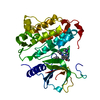

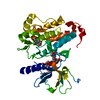
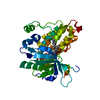
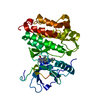
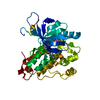



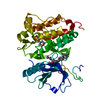
 PDBj
PDBj













